

Best of Education. Listen Current - Lesson Plans for Science, Social Studies, and ELA.
Google Hangouts etc. Questioning; Challenge & Engagement. How to Light a Bunsen Burner. Things May Look Tense on the Surface! Windows 8 apps for education. Charge up your PLN! Nuzzel - News From Your Friends. SurvivalTips. Peggy George - Phoenix, Arizona, B.A., M.Ed.,Ed.D.
Peggy George has been a professional educator for over 45 years.
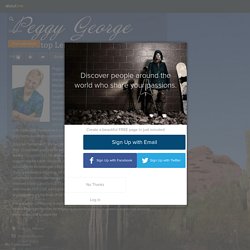
She completed her BA in Elementary Education at Arizona State University, and earned her M.Ed. and Ed.D. degrees from the University of Massachusetts-Amherst in Reading/Open Education and Teacher Education. She began her teaching career in Special Education and has taught grades 1-6. She has had many administrative/leadership roles throughout her career including elementary principal (23 years), special education director, director of a private school for the deaf, coordinator of a Professional Development School (PDS) program in the Madison District for ASU-West, and teacher education instructor at ASU-West. Courses she has taught include action research, classroom instruction and management, curriculum organization, technology integration in the K-12 classroom, classroom assessment, and the student teaching capstone seminar.
Weaving is believing. It’s almost impossible to imagine doing chemistry today without pictures – without some concept, however schematic, of what molecules look like.
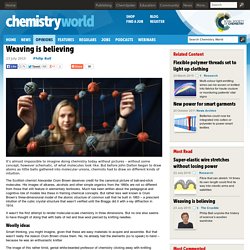
But before John Dalton began to draw atoms as little balls gathered into molecular unions, chemists had to draw on different kinds of intuition. The Scottish chemist Alexander Crum Brown deserves credit for the canonical picture of ball-and-stick molecules. His images of alkanes, alcohols and other simple organics from the 1860s are not so different from those that still feature in elementary textbooks. Much has been written about the pedagogical and cognitive role of models like these in framing chemical concepts. But rather less well known is Crum Brown’s three-dimensional model of the atomic structure of common salt that he built in 1883 – a prescient intuition of the cubic crystal structure that wasn’t verified until the Braggs did it with x-ray diffraction in 1914. Woolly ideas. Simple poster printing at home! - Block Posters.
QR Code Generator: QR Stuff Free Online QR Code Creator And Encoder For Brochures, Print Advertising, Business Cards & Stickers. Images for Students & Teachers to Use in Word Problems, Math Stories, & Other Projects. Shelly. Registration. Summer PD. The summer is a great time to learn a new skill, develop new ideas, and create new lessons to take into your classroom in the fall.

This summer I’m offering a handful of online professional development opportunities. Two of them carry graduate credit options and all of them provide certificates for professional development hours. All courses feature live webinars with Q& A forums. All webinars are recorded for students to watch at their leisure if they miss a class. Getting Going With GAFE (Google Apps for Education) Getting Going With GAFE is a five week course covering everything you need to know to integrate Google Drive, Google Classroom, Google Calendar, and Google Sites into your practice. Blogs & Social Media for Teachers & School Leaders Teaching History With Technology History teachers come learn with me, Richard Byrne, and Ken Halla of US and World History Teachers’ Blogs.
14 Ways to Make Teachers, Students, AND Parents Happy with Just One Tool! Finally a Tool and Resource to Fit Everyone's Needs As a classroom teacher, I'm always on the look out for resources that will help my students in class and support the work they do at home as well.
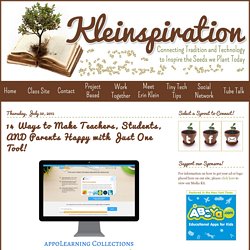
Over the years, I've gathered binders full of information, computer files full of information, and now Pinterest boards full of information. International Dot Day : Thankyou. Apps. Free presentation templates. The Social Learning Network. Jonathan Wylie sur Twitter : "Free #MysterySkype Curriculum for Schools #edtech #edtechchat. Summer PD. Best Places to Work. Awards & Trends Airbnb Best Places to Work Best Places to Work Best Places to Work 44k Share on Facebook Share on Twitter 76k Share on LinkedIn.

Urban Teacher on Twitter: "ALL teachers have the ability to change a life, No student left behind! Illustrated by @sylviaduckworth #ukedchat. Blogging With Students In 5 Simple Steps. There are dozens of reasons why students should blog.
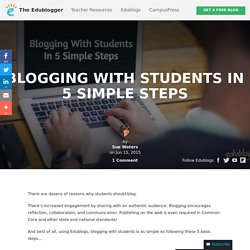
There’s increased engagement by sharing with an authentic audience. Blogging encourages reflection, collaboration, and communication. Publishing on the web is even required in Common Core and other state and national standards! For Educators. How to Play with MakeBeliefsComix.com How to Play: For Educators Click here to watch a video of students at City College, New York, talking about how MakeBeliefsComix.com helps them learn English.
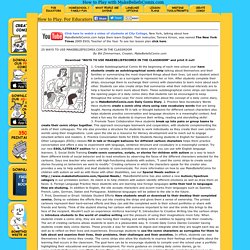
Their instructor, Tamara Kirson, was named The New York Times 2009 ESOL Teacher of the Year. To see her lesson plan click here. International TLQ Course Lisbon Portugal. Edublogs sur Twitter : "Blogging with students in 5 Simple step. Free Tools For Teachers. 10 Published Results Supporting the Benefits of Flipped Learning. The Evidence Indicating That Flipped Instruction Works Continues to Grow Have you ever come across statements online, or overheard people in dialogue, claiming that there is just no evidence supporting the effectiveness of incorporating technology in the educational process?
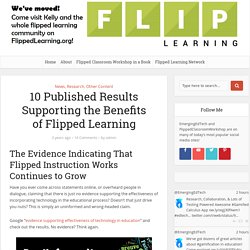
Doesn’t that just drive you nuts? This is simply an uninformed and wrong-headed claim. Google “evidence supporting effectiveness of technology in education” and check out the results. No evidence? Of course, here on this site, were focused on one specific technique that relies on technology make teaching and learning more effective – the flipped classroom or flipped instruction model. Here are 10 published findings and studies that offer qualitative and quantitative results that support the effectiveness of this technique: The Teacher’s Guide To Open Educational Resources. You’ve probably heard about Open Educational Resources and maybe even used some in your classroom.
But the world of OERs is growing constantly, with more quality resources available every day. If you aren’t taking advantage of them yet, now is a great time to take a closer look. What’s so great about OERs? TouchDevelop. Checking for Understanding (CFU) - Wendy Warnes Instructional Technology Coach. Digital Literacy. Comments4Kids. I’m an Educator, What Should I Tweet about? Daydream Education. Ensiapua ohjelmoinnin opettamiseen peruskoulussa.
Why Education in Finland Works. Elvira Bolat sur Twitter : "#ED #technology changing the world @GlobalBU... Host free webinars and web conferences with BigMarker. Meme Me: The Student's Concept of Self in a Digital World. Social Media, Mental Health and Teens - Sue Scheff BlogSue Scheff Blog. Today almost everyone, not only teenagers, are connected to social media.

A Pew Research Center study found that 92 percent of U.S. teenagers use social networks at least once a day, with 24 percent reporting that they are online “almost constantly.” Adults love their social media too. According to PEW Research Center study, 74 percent of adults online use social media with Facebook leading by 71 percent. Teens, Social Media & Technology Overview 2015. 24% of teens go online “almost constantly,” facilitated by the widespread availability of smartphones.

Aided by the convenience and constant access provided by mobile devices, especially smartphones, 92% of teens report going online daily — including 24% who say they go online “almost constantly,” according to a new study from Pew Research Center. 7 Good Options for Building Digital Portfolios - A PDF Handout. Stop Uploading PDF’s and Digital Worksheets. I have received several tweets about how cumbersome it is to have students work with PDF’s in a digital format. I am going to be blunt, uploading your worksheets to PDF’s and putting them online is not a 21st century lesson. This is substitution on the SAMR model. It is a pain to manage digital worksheets. Clipix: Save and organize everything you care about. 10 Tips for Folders in Google Drive. Folders allow you to organize your files in Google Drive. They also allow you to more efficiently share a collection of documents. If you’ve switched to the new Google Drive you can create a folder by clicking on the reddish “NEW” button and choosing folder.
The “Create” button provides the same options if you have not switched over. You can find the folders under “My Drive” on the left hand side of Google Drive. To the left of the My Drive icon is an arrow. You can move your documents to a folder by simply dragging the document from Google Drive to the folder on the left hand side in Google Drive. From the More actions menu choose “Move to” to add to a folder. Hold down the Control key (Command on a Mac) and select multiple documents that you want to add to a folder. Documents in a folder inherit the sharing permissions of the folder. Select the folder you want to share and click on the share icon in the toolbar. Epic EdCamp Global Collaborative Movie. The Busy Life of Busy Me - Periscope. My Week. Cosmic Light EDU kit.
Austin Gagnier on Twitter: "15 Things Every Teacher should do Next Year: #lkdsb @alicekeeler #TVDSB #peelmathchat @JennKranenburg @Mag_Colquhoun. Sylvia Duckworth on Twitter: "8 Things to Look for in Today's Class by @gcouros #edtech @langwitches @ICTEvangelist @rockourworld #elemchat. The Perseid Meteor Begins Its Peak TONIGHT - Don't Miss It! Forbes Welcome. Great idea! #teaching #edchat.